Cow Longevity and Reasons and Risk Factors for Culling in South African Holstein and Jersey Dairy Herds
Simple Summary
Abstract
1. Introduction
2. Materials and Methods
2.1. Study Population and Data Collection
2.2. Data Preparation and Editing
2.3. Statistical Analysis
- Logit (p) is the probability of culling (1 = yes, 0 = no);
- Β0 is the intercept of the regression line;
- β1 is the regression coefficient for parity;
- X1 is parity (discrete predictor);
- β2 is the regression coefficient for herd size;
- X2 is herd size (discrete predictor);
- β3 is the regression coefficient for calving season;
- X3 is calving season (discrete predictor);
- Ɛ is the random error.
3. Results
3.1. Descriptive Statistics for Cow Longevity
3.2. Cow Survival Rate by Length of Productive Life
3.3. Cow Survival Rate Based on Different Parities
3.4. Distribution of Culling Reasons
3.5. Proportions of Involuntary and Voluntary Culling
3.6. Risk Factors for Culling
3.7. Calving Season
3.8. Parity
3.9. Herd Size
4. Discussion
5. Conclusions
Author Contributions
Funding
Institutional Review Board Statement
Informed Consent Statement
Data Availability Statement
Acknowledgments
Conflicts of Interest
References
- International Farm Comparison Network Report. 2023. Available online: http://dairyreport.online (accessed on 29 August 2025).
- Idesa, G.D.; Aman, S. Assessment of the reasons for culling and its relation to age at culling in dairy cows in and around Mekelle City, Tigray, Ethiopia. J. Vet. Med. 2021, 6, 1–5. [Google Scholar] [CrossRef]
- Wakchaure, R.; Ganguly, S.; Para, P.A. A review on disposal (culling and mortality) of cattle. J. Lab. Life Sci. 2015, 1, 8–16. [Google Scholar]
- Nor, N.M.; Steeneveld, W.; Hogeveen, H. The average culling rate of Dutch dairy herds over the years 2007 to 2010 and its association with herd reproduction, performance and health. J. Dairy Res. 2014, 81, 1–8. [Google Scholar] [CrossRef]
- Haine, D.; Delgado, H.; Cue, R.; Sewalem, A.; Wade, K.; Lacroix, R. Culling from the herd’s perspective—Exploring herd-level management factors and culling rates in Québec dairy herds. Prev. Vet. Med. 2017, 1, 132–141. [Google Scholar] [CrossRef]
- Rilanto, T.; Reimus, K.; Orro, T.; Emanuelson, U.; Viltrop, A.; Mõtus, K. Culling reasons and risk factors in Estonian dairy cows. Vet. Sci. 2020, 16, 173. [Google Scholar] [CrossRef] [PubMed]
- Cook, N.B. Symposium review: The impact of management and facilities on cow culling rates. J. Dairy Sci. 2020, 103, 3846–3855. [Google Scholar] [CrossRef] [PubMed]
- Armengol, R.; Fraile, F. Descriptive study for culling and mortality in five high-producing Spanish dairy cattle farms (2006–2016). Acta Vet. Scand. 2018, 60, 2–11. [Google Scholar] [CrossRef]
- De Vries, A. Economic trade-offs between genetic improvement and longevity in dairy cattle. J. Dairy Sci. 2017, 100, 4184–4192. [Google Scholar] [CrossRef] [PubMed]
- Nor, N.M.; Steeneveld, W.; Mourits, M.; Hogeveen, H. The optimal number of heifer calves to be reared as dairy replacements. J. Dairy Sci. 2015, 98, 861–871. [Google Scholar] [CrossRef]
- Cockram, M. Condition of animals on arrival at the abattoir and their management during lairage. In The Slaughter of Farmed Animals: Practical Ways of Enhancing Animal Welfare; CABI Publishing: Wallingford, UK, 2020; pp. 49–77. [Google Scholar]
- Vredenberg, I.; Han, R.; Mourits, M.; Hogeveen, H.; Steeneveld, W. An Empirical Analysis on the Longevity of Dairy Cows in Relation to Economic Herd Performance. Front. Vet. Sci. 2021, 8, 64667. [Google Scholar] [CrossRef]
- Diniso, Y.S.; Jaja, I.F. A retrospective survey of the factors responsible for culling and mortality in dairy farms in the eastern cape province, South Africa. Sci. Afr. 2021, 12, e00838. [Google Scholar] [CrossRef]
- Dallago, G.M.; Wade, K.M.; Cue, R.I.; Mcclure, J.T.; Lacroix, R.; Pellerin, D.; Vasseur, E. Keeping Dairy Cows for Longer: A Critical Literature Review on Dairy Cow Longevity in High Milk-Producing Countries. Animals 2021, 11, 808. [Google Scholar] [CrossRef]
- Compton, C.W.R.; Heuer, C.; Thomsen, P.T.; Carpenter, T.E.; Phyn, C.V.C.; Mcdougall, S. Invited review: A systematic literature review and meta-analysis of mortality and culling in dairy cattle. J. Dairy Sci. 2017, 100, 1–16. [Google Scholar] [CrossRef]
- Hogeveen, H.; Van Soest, F.J.; Van Der Voort, M. Economics for the veterinary practitioner: From burden to blessing. In Proceedings of the 29th World Buiatrics Congress, Dublin, Ireland, 3–8 July 2016; pp. 72–75. [Google Scholar]
- Sewalem, A.; Miglior, F.; Kistemaker, G.J. Analysis of the relationship between workability traits and functional longevity in Canadian dairy breeds. J. Dairy Sci. 2010, 93, 4359–4365. [Google Scholar] [CrossRef]
- Boujenane, I. Reasons and risk factors for culling of Holstein dairy cows in Morocco. J. Livest. Sci. Technol. 2017, 5, 25–31. [Google Scholar]
- Williams, K.E.B.; Berke, O.; Pearl, D.L.; Hand, K.; Kelton, D.F. Heat stress related dairy cow mortality during heat waves and control periods in rural Southern Ontario from 2010–2012. BMC Vet. Res. 2015, 11, 291. [Google Scholar]
- Oduniyi, O.S.; Rubhara, T.T.; Antwi, M.A. Sustainability of Livestock Farming in South Africa. Outlook on Production Constraints, Climate-Related Events, and Upshot on Adaptive Capacity. Sustainability 2020, 12, 2582. [Google Scholar] [CrossRef]
- Galloway, C.; Conradie, B.; Prozesky, H.; Elser, K. Opportunities to improve sustainability on commercial pasture-based dairy farms by assessing environmental impact. Agric. Syst. 2018, 166, 1–9. [Google Scholar] [CrossRef]
- Sihlobo, W. Key challenges that constrained SA’s agricultural fortunes in 2023. Available online: https://www.agbiz.co.za/content/open/11-december-2023-agri-market-viewpoint-102 (accessed on 11 December 2023).
- Gertenbach, W.D. Breeds of Cattle Breeds. Dairying in KwaZulu-Natal. Department of Agriculture and Rural Development. Available online: https://www.google.com/url?sa=t&source=web&rct=j&opi=89978449&url=https://www.kzndard.gov.za/images/Documents/RESOURCE_CENTRE/GUIDELINE_DOCUMENTS/PRODUCTION_GUIDELINES/Dairying_in_KwaZulu-Natal/Breeds%2520of%2520Dairy%2520Cattle.pdf&ved=2ahUKEwj2zp3HlNyPAxUwRCoJHWvlAUsQFnoECBgQAQ&usg=AOvVaw3LbGedq-QOIOkxPowg1fsn (accessed on 1 August 2025).
- Mostert, B.E.; Theron, H.E.; Kanfer, F.H.J.; Van Marle-Koster, E. Adjustment of heterogeneous variances and a calving year effect in test-day models for national genetic evaluation of dairy cattle in South Africa. S. Afr. J. Anim. Sci. 2006, 36, 165–174. [Google Scholar] [CrossRef]
- Associazione Italiana Allevatori. 2020. Bollettino Online. Rome (Italy). Available online: https://aia.it/bollettino-a-i-a/ (accessed on 23 June 2021).
- Martens, H.; Bange, C. Longevity of high producing dairy cows: A case study. Lohmann Inf. 2013, 48, 53. [Google Scholar]
- Theron, H.E.; Moster, B.E. Production and breeding performance of South African dairy breeds. In Proceedings of the 10th World Conference for Animal Production, Cape Town, South Africa, 23–28 November 2008; pp. 206–210. [Google Scholar]
- Egger-Danner, C.; Cole, J.B.; Pryce, J.E.; Gengler, N.; Heringstad, B.; Bradley, A.; Stock, K.F. Invited review: Overview of new traits and phenotyping strategies in dairy cattle with a focus on functional traits. Animals 2015, 9, 191–207. [Google Scholar] [CrossRef]
- Leso, L.; Pellegrini, P.; Barbari, M. Effect of housing systems on performance and longevity of dairy cows in Northen Italy. Agron. Res. 2019, 17, 574–581. [Google Scholar]
- De Vries, A.; Marcondes, I.M. Review: Overview of factors affecting p affecting productive lifespan of dairy cows. Anim. Sci. 2020, 14, 155–164. [Google Scholar]
- Banga, C.B.; Neser, F.W.C.; Garrick, D.J. Derivation of economic values of longevity for inclusion in the breeding objectives for South African dairy cattle. Conf. Agric. Biotechnol. 2013, 60, 69–73. [Google Scholar]
- Strapak, P.; Juhas, P.; Strapakova, E.; Halo, M. Relation of the length of productive life and the body conformation traits in Slovak Simmental breed. Anim. Biol. 2010, 4, 393–402. [Google Scholar]
- Raguz, N.; Jovanovac, S.; Gantner, V.; Meszaros, G.; Solkner, J. Analysis of factors affecting the length of productive life in Croatian dairy cows. J. Agric. Sci. 2011, 17, 232–240. [Google Scholar]
- Horvath, J.; Toth, Z.; Miko, E. The analysis of production and culling rate with regard to the profitability in a dairy herd. Adv. Res. Life Sci. 2017, 1, 48–52. [Google Scholar] [CrossRef]
- Pipino, D.F.; Piccardi, M.; Lopez-Villalobos, N.; Hickson, R.E.; Vázquez, M.I. Fertility and survival of Swedish Red and White × Holstein crossbred cows and purebred Holstein cows. J. Dairy Sci. 2023, 106, 2475–2486. [Google Scholar] [CrossRef]
- Costa, A.; Buonaiutoa, G.; Visentina, G.; Nierob, G.; Deganoc, L.; Cavallinia, D.; Mammia, L.M.E.; Palmonaria, A.; Formigonia, A.; Lopez-Villalobosd, N. The effect of first lactation calving season, milk production, and morphology on the survival of Simmental cows. Animal 2024, 18, 101128. [Google Scholar] [CrossRef] [PubMed]
- Adamczyk, K.; Makulska, J.; Jagusiak, W.; Weglarz, A. Associations between strain, herd size, age at first calving, culling reason and lifetime performance characteristics in Holstein Friesian cows. Anim. Consort. 2016, 11, 327–334. [Google Scholar] [CrossRef] [PubMed]
- Kerslake, J.I.; Amer, P.R.; O’neill, P.L.; Wong, S.L.; Roche, J.R.; Phyn, C.V.C. Economic costs of recorded reasons for cow mortality and culling in a pasture-based dairy industry. J. Dairy Sci. 2018, 101, 1795–1803. [Google Scholar] [CrossRef]
- Workie, Z.W.; Gibson, J.P.; Van Der Werf, J.H. Analysis of culling reasons and age at culling in Australian dairy cattle. Anim. Product. Sci. 2021, 61, 680–689. [Google Scholar] [CrossRef]
- Fahim, N.H.; Ibrahim, M.A.-A.M.; Amin, A.H.; Sadek, R.R. Milk Production and Reproductive Performance of Retained and Culled Cows in a Large Holstein Herd in Egypt. J. World Vet. 2021, 10, 474–483. [Google Scholar] [CrossRef]
- Cortez De Souza, T.; Pinto, L.F.B.; Rocha Da Cruz, V.R.; Rojas De Oliveira, H.; Pedrosa, V.B.; Gerson, A.J.; Miglior, F.; Schenkel, F.S.; Brito, L.F. A comprehensive characterization of longevity and culling reasons in Canadian Holstein cattle based on various systematic factors. Am. Soc. Anim. Sci. 2023, 7, txad102. [Google Scholar] [CrossRef]
- Kulkarni, P.S.; Mourits, M.C.M.; Slob, J.; Veldhuis, A.M.B.; Nielen, M.; Hogeveen, H.; Van Schaik, G.; Steeneveld, W. Dutch dairy farmers’ perspectives on culling reasons and strategies. Prev. Vet. Med. 2023, 218, 105997. [Google Scholar] [CrossRef]
- Makgahlela, L.M.; Banga, C.B.; Norris, D.; Dzama, K.; Ngambi, J.W. Genetic correlations between female fertility and production traits in South African Holstein cattle. S. Afr. J. Anim. Sci. 2007, 37, 180–188. [Google Scholar] [CrossRef]
- Mostert, B.E.; Van Der Westhuizen, R.; Theron, H.E. Calving interval genetic parameters and trends for dairy breeds in South Africa. S. Afr. J. Anim. Sci. 2010, 40, 162–165. [Google Scholar] [CrossRef]
- Crowe, M.A.; Hostens, M.; Opsomer, G. Reproductive management in dairy cows-the future. Ir. Vet. J. 2018, 71, 1–13. [Google Scholar] [CrossRef] [PubMed]
- Braganca, L.G.; Zangirolamo, A.F. Strategies for increasing fertility in high productivity dairy herds. J. Anim. Reprod. 2018, 15, 256–260. [Google Scholar] [CrossRef] [PubMed]
- Karzis, J.; Petzer, I.M.; Donkin, E.F.; Naidoo, V.; Etter, E.M. Surveillance of antibiotic resistance of maltose-negative Staphylococcus aureus in South African dairy herds. Antibiotics 2020, 9, 616. [Google Scholar] [CrossRef]
- Khasapane, N.G.; Khumalo, Z.T.H.; Kwenda, S.; Nkhebenyane, S.J.; Thekisoe, O. Characterisation of milk microbiota from subclinical mastitis of apparent healthy dairy cattle in Free State Province, South Africa. Vet. Sci. 2023, 10, 616. [Google Scholar] [CrossRef]
- Dube, B.; Banga, C.B.; Dzama, K.; Norris, D. Genetic analysis of somatic cell scores and linear type traits in South 72 African Holstein cattle. S. Afr. J. Anim. Sci. 2008, 8, 229–232. [Google Scholar]
- Sharma, S.; Gupta, D.K.; Bansal, B.K. Udder and Teat Skin Lesions in Bovines. Int. J. Livest. Res. 2020, 10, 1–14. [Google Scholar] [CrossRef]
- Martin, P.; Barkema, H.W.; Brito, L.F.; Narayana, S.G.; Miglior, F. Symposium review: Novel strategies to genetically improve mastitis resistance in dairy cattle. J. Dairy Sci. 2018, 101, 2724–2736. [Google Scholar] [CrossRef]
- Weigel, K.A.; Shook, G.E. Genetic Selection for Mastitis Resistance. Vet. Clin. Food Anim. Pract. 2018, 34, 457–472. [Google Scholar] [CrossRef]
- Ghaderi-Zefrehei, M.; Rabbanikhah, E.; Baneh, H.; Peters, S.; Imumorin, I. Analysis of culling records and estimation of genetic parameters for longevity and some production traits in Holstein dairy cattle. J. Appl. Anim. Res. 2017, 45, 524–528. [Google Scholar] [CrossRef]
- Tufarelli, V.; Puvača, N.; Glamočić, D.; Pugliese, G.; Colonna, M.A. The Most Important Metabolic Diseases in Dairy Cattle during the Transition Period. Animals 2024, 14, 816. [Google Scholar] [CrossRef] [PubMed]
- Ahlman, T.; Berglund, B.; Rydhmer, L.; Strandberg, E. Culling reasons in organic and conventional dairy herds and genotype by environment interaction for longevity. J. Dairy Sci. 2012, 94, 1568–1575. [Google Scholar] [CrossRef]
- Haskell, M.J.; Rennie, L.J.; Bowell, V.A.; Bell, M.J.; Lawrence, B.A. Housing system, milk production, and zero-grazing effects on lameness and leg injury in dairy cows. J. Dairy Sci. 2006, 89, 4259–4266. [Google Scholar] [CrossRef]
- Cook, N.B.; Nordlund, K.V. The influence of the environment on dairy cow behavior, claw health and herd lameness dynamics. Vet. J. 2009, 179, 360–369. [Google Scholar] [CrossRef]
- Cook, N.B.; Hess, J.P.; Foy, M.R.; Bennett, T.B.; Brotzman, R.L. Management characteristics, lameness, and body injuries of dairy cattle housed in high-performance dairy herds in Wisconsin. J. Dairy Sci. 2016, 99, 5879–5891. [Google Scholar] [CrossRef]
- Muller, C.J.C.; De Waal, H.L. The Effect of Herd Structure on the Performance of Dairy Herds; Newsletter Article; ARC: Yokohama, Japan, 2016. [Google Scholar]
- Imbayarwo-Chikosi, V.E.; Ducrocq, V.; Banga, C.B.; Halimani, T.E.; Van Wyk, J.B.; Maiwashe, A.; Dzama, K. Estimation of genetic parameters for functional longevity in the South African Holstein cattle using a piecewise Weibull proportional hazards model. J. Anim. Breed. Genet. 2017, 134, 364–372. [Google Scholar] [CrossRef]
- Alvåsen, K.; Dohoo, I.; Roth, A.; Emanuelson, U. Farm characteristics and management routines related to cow longevity: A survey among Swedish dairy farmers. Acta Vet. Scand. 2018, 60, 1–11. [Google Scholar] [CrossRef]
- Bahrampour, J.; Danesh Mesgaran, M.; Arabpour, A.R.; Vakili, A.R.; Khezri, A. Risk factors affecting the culling of Iranian Holstein dairy cows. J. Livest. Sci. Technol. 2016, 4, 15–23. [Google Scholar]
- Probo, M.; Bogado Pascottini, O.; Leblanc, S.; Opsomer, G.; Hostens, M. Association between metabolic diseases and the culling risk of high-yielding dairy cows in a transition management facility using survival and decision tree analysis. J. Dairy Sci. 2018, 101, 9419–9429. [Google Scholar] [CrossRef] [PubMed]
- Tao, S.; Dahl, G.E. Invited review: Heat stress effects during late gestation on dry cows and their calves. J. Dairy Sci. 2013, 96, 4079–4093. [Google Scholar] [CrossRef] [PubMed]
- Canadian Dairy Network: Enhancements and Updates. Available online: https://www.cdn.ca/document.php?id=516 (accessed on 15 May 2020).
- Fodor, I.; Lang, Z.; Ozsvari, L. Relationship of dairy heifer reproduction with survival to first calving, milk yield and culling risk in the first lactation. Asian-Australas. J. Anim. Sci. 2020, 33, 1360. [Google Scholar] [CrossRef]
- De Vries, A.; Olson, J.D.; Pinedo, P.J. Reproductive risk factors for culling and productive lifespan of dairy cows. J. Dairy Sci. 2010, 93, 1002–1011. [Google Scholar]
- Pinedo, P.J.; Daniels, A.; Shumaker, J.; De Vries, A. Dynamics of culling risk with disposal codes reported by Dairy Herd Improvement (DHI) herds. J. Dairy Sci. 2014, 97, 288–297. [Google Scholar]
- Smith, J.W.; Ely, L.O.; Chapa, A.M. Effect of Region, Herd Size, and Milk Production on Reasons Cows Leave the Herd. J. Dairy Sci. 2000, 83, 2980–2987. [Google Scholar] [CrossRef]
- Hadley, G.L.; Wolf, C.A.; Harsh, S.B. Dairy cattle culling patterns, explanations, and implications. J. Dairy Sci. 2006, 89, 2286–2296. [Google Scholar] [CrossRef]
- Han, R.; Mourits, M.; Steeneveld, W.; Hogeveen, H. The association of herd performance indicators with dairy cow longevity: An empirical study. PLoS ONE 2022, 17, e0278204. [Google Scholar] [CrossRef]
- Barkema, H.W.; Von Keyserlingk, M.A.G.; Kastelic, J.P.; Lam, T.J.G.M.; Luby, C.; Roy, J.P. Invited review: Changes in the dairy industry affecting dairy cattle health and welfare. J. Dairy Sci. 2015, 98, 7426–7445. [Google Scholar] [CrossRef]
- Evink, T.L.; Endres, M.I. Management, operational, animal health, and economic characteristics of large dairy herds in 4 states in the Upper Midwest of the United States. J. Dairy Sci. 2017, 100, 9466–9475. [Google Scholar] [CrossRef] [PubMed]
- Motus, K.; Rilanto, T.; Viidu, D.A.; Orro, T.; Viltrop, A. Seroprevalence of selected endemic infectious diseases in large-scale Estonian dairy herds and their associations with cow longevity and culling rates. Prev. Vet. Med. 2021, 192, 10538. [Google Scholar] [CrossRef] [PubMed]
- Abin, S.; Visser, C.; Banga, C.B. Comparative performance of dairy cows in low-input smallholder and high-input production systems in South Africa. Trop. Anim. Health Prod. 2018, 50, 1479–1484. [Google Scholar] [CrossRef]
- Fetrow, J.; Nordlund, K.V.; Norman, H.D. Invited Review: Culling: Nomenclature, Definitions, and Recommendations. J. Dairy Sci. 2006, 89, 1896–1905. [Google Scholar] [CrossRef] [PubMed]
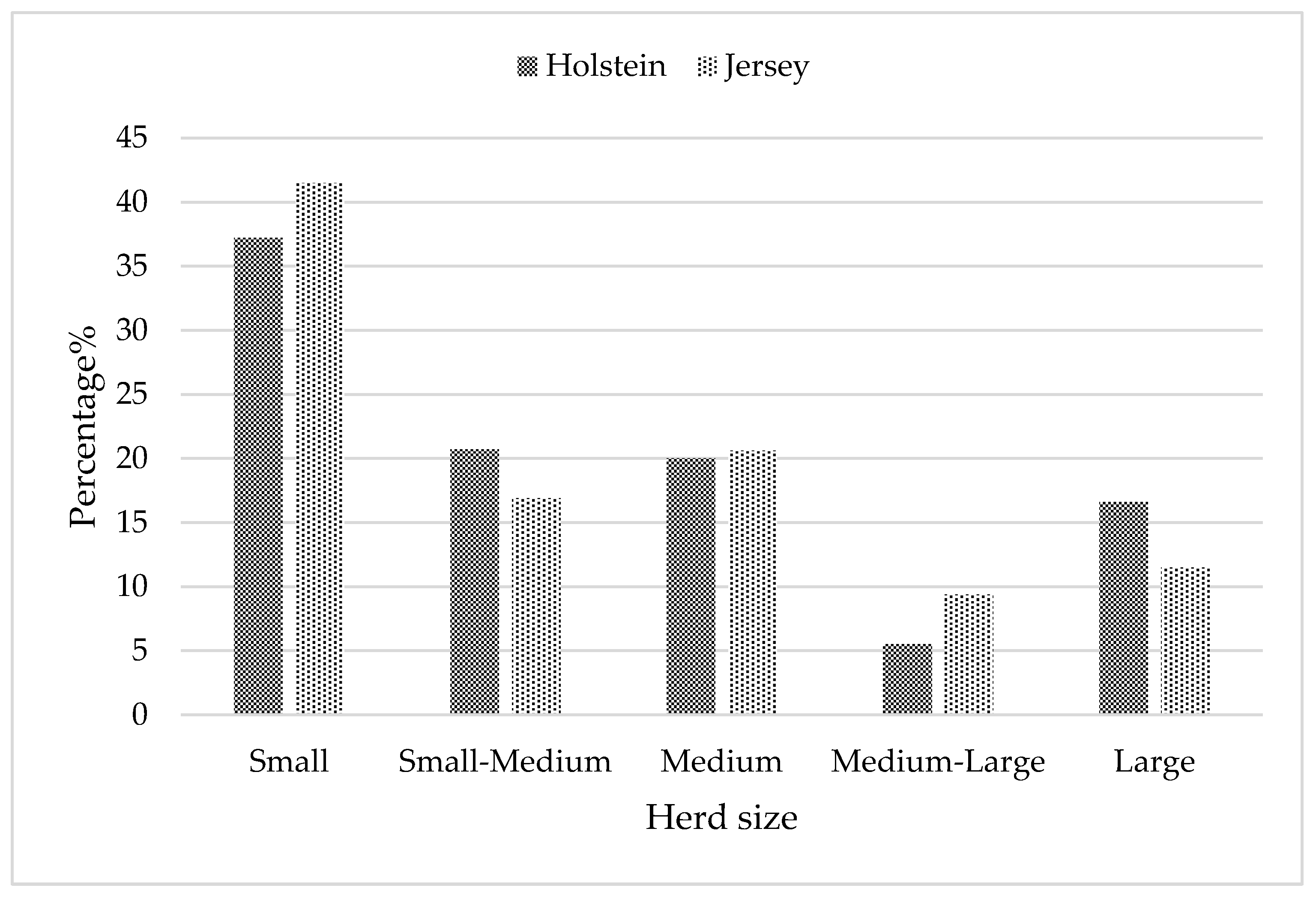
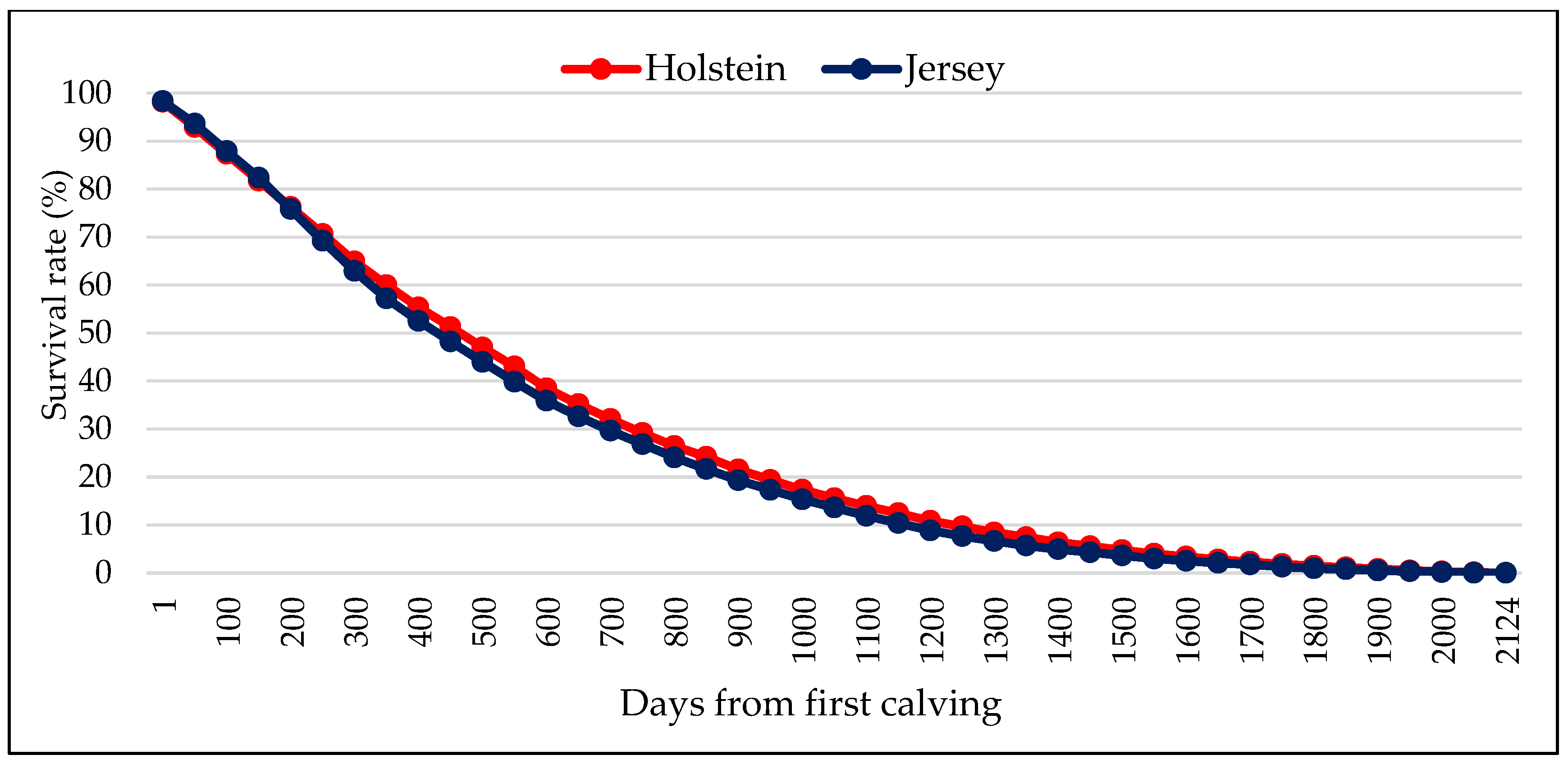
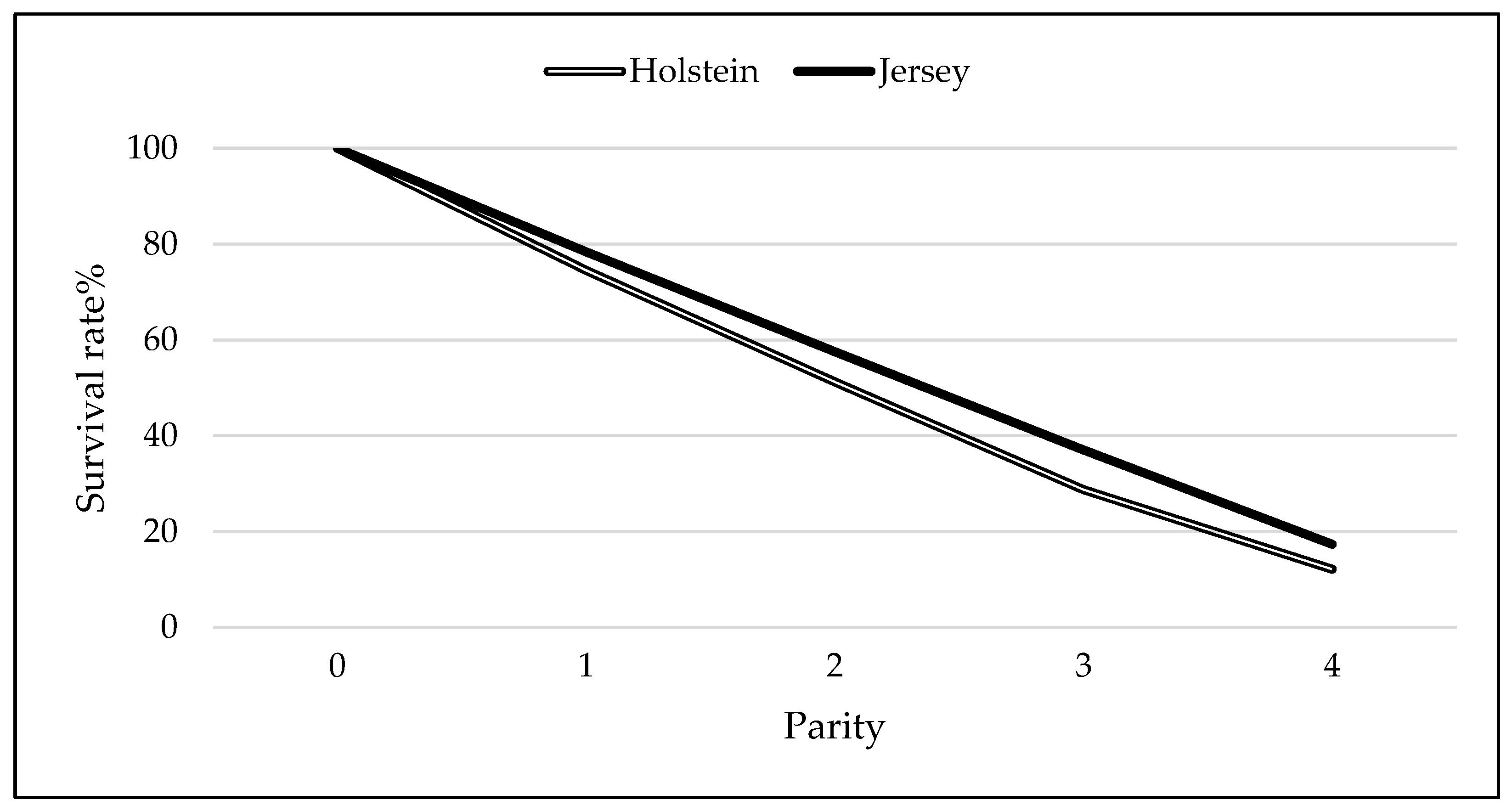
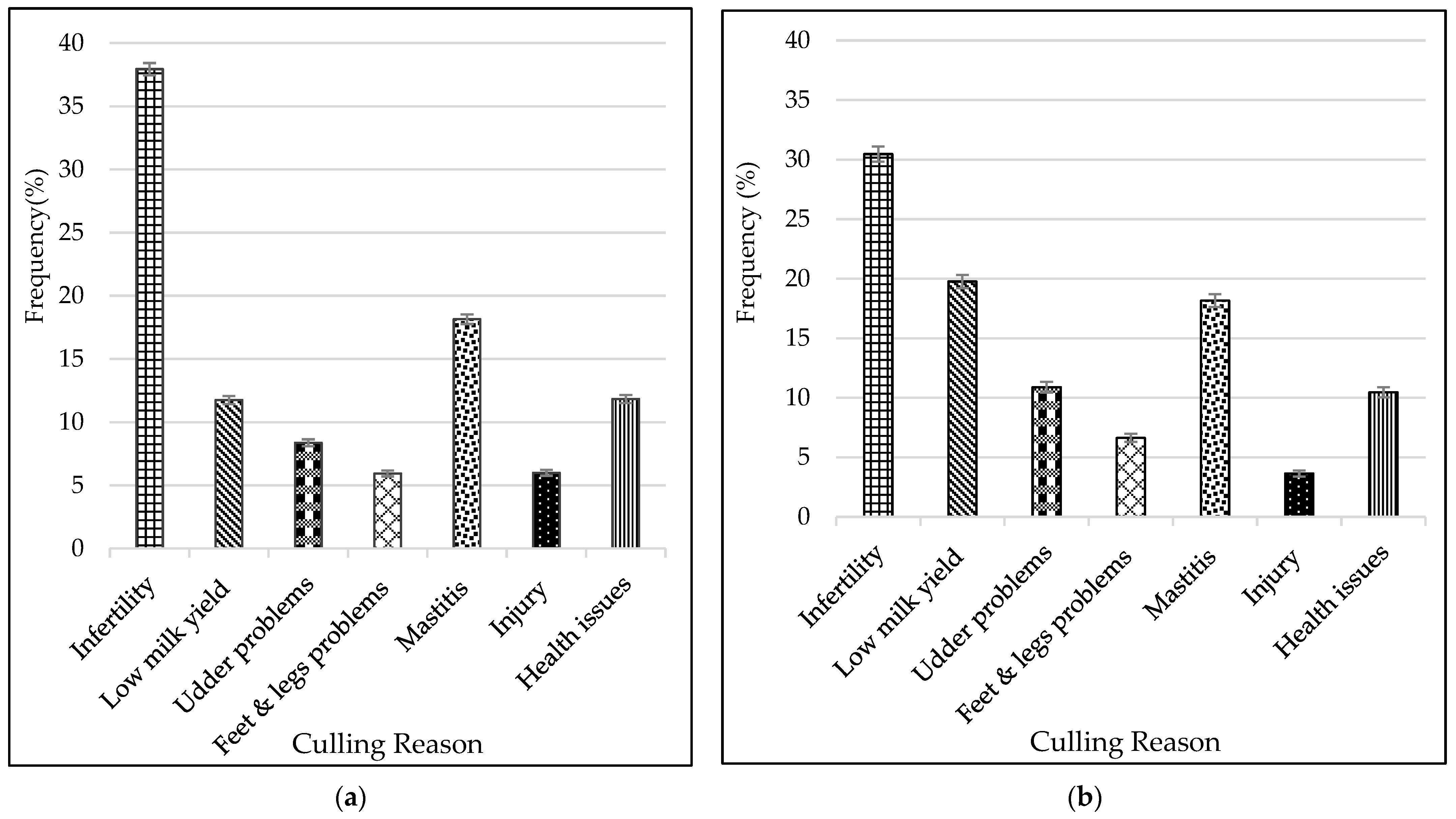
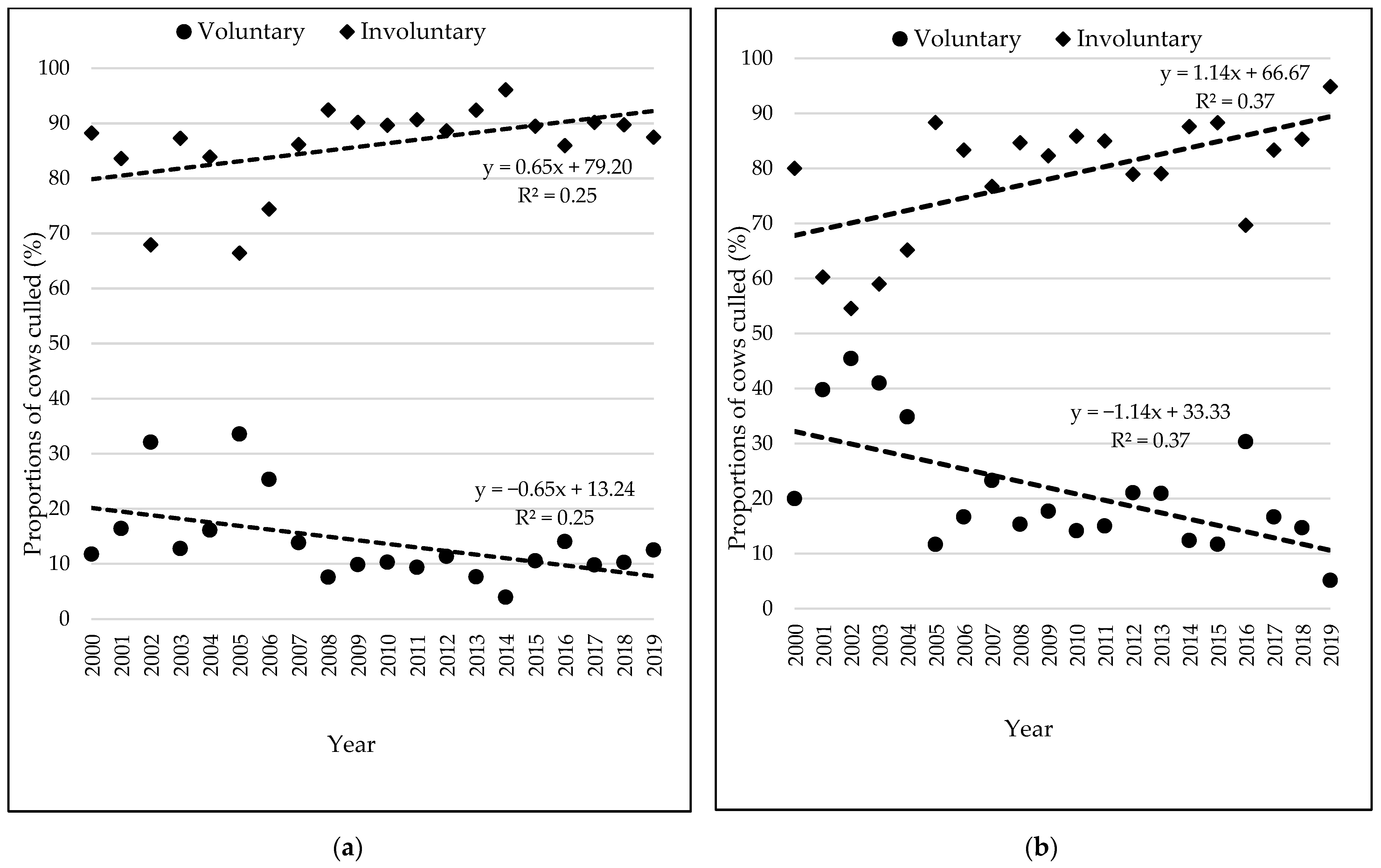
| Lactation Number | Calving Age (Months) | |
|---|---|---|
| Holstein | Jersey | |
| 1 | 20–42 | 17–40 |
| 2 | 30–54 | 29–53 |
| 3 | 40–67 | 41–67 |
| 4 | 50–79 | 53–77 |
| 5 | 60–91 | 65–89 |
| 6 | 70–103 | 77–101 |
| 7 | 80–115 | 89–113 |
| 8 | 90–127 | 113–137 |
| Breed | Trait | Mean | SE | Minimum | Maximum |
|---|---|---|---|---|---|
| Holstein | Length of productive life (days) | 739.33 | 434.31 | 1 | 2124 |
| Number of lactations | 2.37 | 1.08 | 1 | 7 | |
| Age at first calving (months) | 28.6 | 7.9 | 20.0 | 143.0 | |
| Milk yield in (kg) | 8912 | 4927 | 595 | 47,337 | |
| Jersey | Length of productive life (days) | 696.81 | 415.44 | 1 | 2121 |
| Number of lactations | 2.47 | 1.13 | 1 | 8 | |
| Age at first calving (months) | 26.9 | 6.7 | 17.0 | 139.0 | |
| Milk yield in (kg) | 5150 | 2466 | 483 | 24,569 |
| Factor | Holstein | Jersey | ||||
|---|---|---|---|---|---|---|
| Wald-χ2 | SE | p-Value | Wald-χ2 | SE | p-Value | |
| Calving season | 48.04 | 0.024 | <0.0001 | 64.47 | 0.031 | <0.0001 |
| AFC | 0.04 | 0.023 | 0.8234 | 1.10 | 0.026 | 0.2939 |
| Parity | 10.41 | 0.011 | 0.0013 | 3.88 | 0.013 | 0.0486 |
| Herd size | 128.80 | 0.014 | <0.0001 | 107.86 | 0.013 | <0.0001 |
| Breed | Factor | Odds Ratio | 95% Wald Confidence Intervals | p-Value | |
|---|---|---|---|---|---|
| Lower | Upper | ||||
| Holstein | Calving season | ||||
| Summer | 1.000 | - | - | - | |
| Winter | 0.752 | 0.703 | 0.804 | <0.0001 | |
| Autumn | 0.829 | 0.775 | 0.888 | 0.174 | |
| Spring | 0.850 | 0.792 | 0.913 | 0.868 | |
| Parity | |||||
| 1 | 1.000 | - | - | - | |
| 2 | 1.205 | 1.127 | 1.288 | <0.0001 | |
| 3 | 1.461 | 1.364 | 1.564 | <0.0001 | |
| 4 | 0.855 | 0.797 | 0.916 | <0.0001 | |
| Herd size | |||||
| Small | 1.000 | - | - | - | |
| Small–medium | 0.898 | 0.843 | 0.957 | <0.0001 | |
| Medium | 0.842 | 0.789 | 0.900 | <0.0001 | |
| Medium–large | 0.487 | 0.423 | 0.560 | <0.0001 | |
| Large | 0.659 | 0.611 | 0.712 | <0.0001 | |
| Jersey | Calving season | ||||
| Summer | 1.000 | - | - | - | |
| Winter | 0.671 | 0.616 | 0.731 | <0.0001 | |
| Autumn | 0.847 | 0.773 | 0.927 | 0.797 | |
| Spring | 0.879 | 0.805 | 0.959 | 0.097 | |
| Parity | |||||
| 1 | 1.000 | - | - | - | |
| 2 | 1.170 | 1.070 | 1.280 | 0.076 | |
| 3 | 1.465 | 1.341 | 1.602 | <0.0001 | |
| 4 | 0.897 | 0.825 | 0.979 | <0.0001 | |
| Herd size | |||||
| Small | 1.000 | - | - | - | |
| Small–medium | 0.879 | 0.808 | 0.956 | <0.0001 | |
| Medium | 0.446 | 0.404 | 0.494 | <0.0001 | |
| Medium–large | 0.740 | 0.660 | 0.829 | 0.619 | |
| Large | 0.854 | 0.774 | 0.943 | 0.002 | |
Disclaimer/Publisher’s Note: The statements, opinions and data contained in all publications are solely those of the individual author(s) and contributor(s) and not of MDPI and/or the editor(s). MDPI and/or the editor(s) disclaim responsibility for any injury to people or property resulting from any ideas, methods, instructions or products referred to in the content. |
© 2025 by the authors. Licensee MDPI, Basel, Switzerland. This article is an open access article distributed under the terms and conditions of the Creative Commons Attribution (CC BY) license (https://creativecommons.org/licenses/by/4.0/).
Share and Cite
Matjila, L.; Nephawe, K.; Sanarana, Y.; Dube, B.; Banga, C. Cow Longevity and Reasons and Risk Factors for Culling in South African Holstein and Jersey Dairy Herds. Animals 2025, 15, 3012. https://doi.org/10.3390/ani15203012
Matjila L, Nephawe K, Sanarana Y, Dube B, Banga C. Cow Longevity and Reasons and Risk Factors for Culling in South African Holstein and Jersey Dairy Herds. Animals. 2025; 15(20):3012. https://doi.org/10.3390/ani15203012
Chicago/Turabian StyleMatjila, Lerato, Khathutshelo Nephawe, Yandisiwe Sanarana, Bekezela Dube, and Cuthbert Banga. 2025. "Cow Longevity and Reasons and Risk Factors for Culling in South African Holstein and Jersey Dairy Herds" Animals 15, no. 20: 3012. https://doi.org/10.3390/ani15203012
APA StyleMatjila, L., Nephawe, K., Sanarana, Y., Dube, B., & Banga, C. (2025). Cow Longevity and Reasons and Risk Factors for Culling in South African Holstein and Jersey Dairy Herds. Animals, 15(20), 3012. https://doi.org/10.3390/ani15203012






